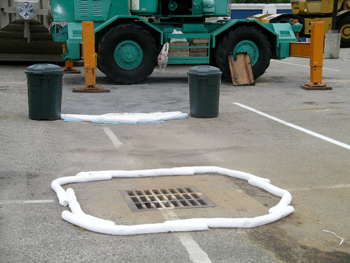 |
|
Please note: This summary is provided to help you understand the regulations. Consult the references provided for links to the full text of the regulations.
This section provides information about the Spill Prevention, Control and Countermeasure (SPCC) rule (40 CFR 112), a regulation that applies to facilities that store, use and consume oil and oil products. Also, covered in this section is Facility Response Planning (40 CFR 112.6), which is applicable to facilities that transfer oil over water to/from vessels In the transportation sector, these rules apply to many terminals and maintenance facilities, depending on their location and the amount of oil stored on site. Examples of oil storage potentially covered by the SPCC rules include gasoline and diesel fuel tanks, drums of lubricating or hydraulic fluid, and transformers containing dielectric fluid. Who is covered by the regulations? The SPCC rule applies to owners or operators of facilities that:
A portion SPCC-regulated facilities may also be subject to Facility Response Planning (FRP) requirements if they pose a threat of "substantial harm" to navigable waters. Facilities are subject to the rule if they meet at least one of the following capacity thresholds:
Materials falling under the rule include, but are not limited to:
Oil storage containers include, but are not limited to:
The SPCC November 5, 2009 amendments designates a subset of qualified facilities as Tier I qualified facilities. Tier I qualified facilities are those that meet the current qualified facilities eligibility criteria and that have no oil storage containers with an individual aboveground storage capacity greater than 5,000 U.S. gallons. All other qualified facilities are designated Tier II qualified facilities. A Tier I qualified facility has reduced requirements under the SPCC rule and has the option to be self-certified (rather than using a professional engineer) by completing an SPCC Plan template. The SPCC rule does not apply to oil carrying pipelines, ships, barges and vehicles (tanker trucks and rail cars). These oil transport operations are instead covered by Department of Transportation (DOT) regulations (49 CFR 130). Every facility subject to SPCC must document its determination of whether or not the facility is subject to Facility Response Planning (FRP) by completing the "Certification of the Applicability of the Substantial Harm Criteria," and maintaining the certification at the facility. The FRP rule applies to owners or operators of facilities that:
The FRP regulation includes two methods by which a facility may be identified as posing substantial harm:
The EPA Regional Administrator may consider factors similar to the self-selection criteria, as well as other factors, including:
What is the purpose of the regulations? The SPCC regulation is intended to prevent oil spills by requiring facilities that store significant amounts of oil to develop and implement a spill prevention and control plan. Of course, just having a plan in place is no guarantee that a spill will not occur. However, in order to fulfill the requirements of the plan the facility operator will need to:
Facilities that meet the criteria (i.e., have sufficient storage capacity, and could reasonably discharge to navigable waters or adjoining shorelines) must comply with the SPCC regulations. These regulations require the facility owner/operator to prepare and implement an SPCC plan for their facility. This plan must be well thought out and prepared in accordance with good engineering practices. It must document the location of storage vessels, types of containment, dangers associated with a major release of material from the tanks, types of emergency equipment available at each site, and procedures for notifying the appropriate regulatory and emergency agencies. If a facility is found to be subject to FRP requirements, either through a self-assessment or by EPA Regional Administrator determination, the facility would be required to develop a facility response plan which would involve, among other requirements, identification of small, medium and worst-case discharge scenarios and response actions; a description of discharge detection procedures and equipment; detailed implementation plans for containment and disposal; diagrams of facility and surrounding layout, topography, and evacuation paths; and employee training, exercises, and drills. To assist facility owners and operators with SPCC compliance, EPA has published a useful document:
For more information:
|
 Spill Prevention, Control and Countermeasure (SPCC) Rule
Spill Prevention, Control and Countermeasure (SPCC) Rule